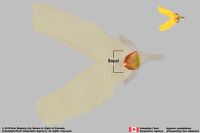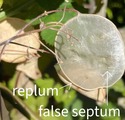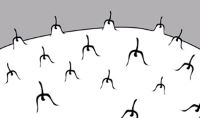Content is from Kirkbride et al. 2006Kirkbride et al. 2006:
Kirkbride JH, Jr, Gunn CR, and Dallwitz MJ. 2006. Family guide for fruits and seeds, vers. 1.0. Accessed September 2020-January 2022. URL: https://nt.ars-grin.gov/seedsfruits/keys/frsdfam/index.cfm ., without modification.
Updates are forthcoming.
Fruits: Pistil(s) simple; 1; 1-pistillate. Fruit anthocarpanthocarp:
simple or compound and including some tissue of non-ovarian origin (accessory tissue) , or pericarpium; simple; capsulecapsule:
, or pericarpium; simple; capsulecapsule:
a dry, dehiscent fruit derived from a compound ovary , or drupedrupe:
, or drupedrupe:
(indehiscent drupe) a fleshy, indehiscent fruit with one more hard pits enclosing seeds, derived from single, superior, simple or compound ovary; (dehiscent drupe) a fruit with a dry or fibrous to fleshy or leathery outer husk that early to tardily breaks apart (or opens), exposing one or more nutlike pits enclosing the seeds , or berryberry:
, or berryberry:
an indehiscent, fleshy fruit with one or a few to many seeds. The flesh may be homogenous throughout. Or, if the outer part is hard, firm, or leathery, referred to as an hesperidium. Septa are present in some, and the seeds may be arillate or with a fleshy testa. (not Spjut), or amphisarcum; loculicidalloculicidal:
(not Spjut), or amphisarcum; loculicidalloculicidal:
type of capsular dehiscence, opening longitudinally through the locules (compare septicidal)
 capsulecapsule:
capsulecapsule:
a dry, dehiscent fruit derived from a compound ovary (Visnea, Ficalhoa); capsulecapsule:
(Visnea, Ficalhoa); capsulecapsule:
a dry, dehiscent fruit derived from a compound ovary not inflated; capsulecapsule:
not inflated; capsulecapsule:
a dry, dehiscent fruit derived from a compound ovary without operculumoperculum:
without operculumoperculum:
a dehiscent cap (or lid) of a seed or fruit that opens during germination or dehiscence ; berryberry:
; berryberry:
an indehiscent, fleshy fruit with one or a few to many seeds. The flesh may be homogenous throughout. Or, if the outer part is hard, firm, or leathery, referred to as an hesperidium. Septa are present in some, and the seeds may be arillate or with a fleshy testa. indehiscent; simple; without persistent central column, or with persistent central column; valves not diverging at top of central column; crowned by ciliateciliate:
indehiscent; simple; without persistent central column, or with persistent central column; valves not diverging at top of central column; crowned by ciliateciliate:
with a marginal fringe of hairs
or not sepalssepal:
a member of the outer envelope of a flower (calyx) , or stylestyle:
, or stylestyle:
in a flower, the narrow and elongated part of the pistil between the stigma and the ovary; sometimes persisting in fruit ; with styles(s), or without stylestyle:
; with styles(s), or without stylestyle:
in a flower, the narrow and elongated part of the pistil between the stigma and the ovary; sometimes persisting in fruit or stylar remnants; at apexapex:
or stylar remnants; at apexapex:
the point farthest from the point of attachment, or the "tip" of an organ ; within accessory organ(s), or not within accessory organ(s); within receptacle and sepals; accrescentaccrescent:
; within accessory organ(s), or not within accessory organ(s); within receptacle and sepals; accrescentaccrescent:
growing continuously
; persistent; more than 1 but less than 10-seeded to many-seeded; 4-seeded (to many); less than 1 cm long to from 5.1–10 cm long; 0.3–5 cm long; with 2–5-carpellate (2–3–5); with carpels united; with carpels remaining united at maturity; with carpels not radiating at maturity; without sterilesterile:
lacking male and/or female reproductive parts; also, not producing fruit or seed
 carpels; without fleshy laterallateral:
carpels; without fleshy laterallateral:
(of embryo) embryo lies along the side of the seed, generally towards one end; of, at, or from the side; in grasses, can refer to the sides adjacent to the dorsal and ventral sides
appendage; in transection tereteterete:
approximately circular in cross section; width and thickness approximately equal
 ; apexapex:
; apexapex:
the point farthest from the point of attachment, or the "tip" of an organ not beakedbeak:
not beakedbeak:
a usually firm, terminal appendage, sometimes tapered , or beaked; apexapex:
, or beaked; apexapex:
the point farthest from the point of attachment, or the "tip" of an organ long beaked; indehiscentindehiscent:
long beaked; indehiscentindehiscent:
not opening on its own, as in a fruit
 , or dehiscentdehiscent:
, or dehiscentdehiscent:
(v. dehisce) splitting open at maturity to release contents (of a fruit) . Dehiscentdehiscent:
. Dehiscentdehiscent:
(v. dehisce) splitting open at maturity to release contents (of a fruit) unit seed(s). Dehiscentdehiscent:
unit seed(s). Dehiscentdehiscent:
(v. dehisce) splitting open at maturity to release contents (of a fruit) irregularly, or regularly; passively; without replumreplum:
irregularly, or regularly; passively; without replumreplum:
the rim, formed by the persistent placentas, and connected by a false septum in Brassicaceae fruits. The fruit valves are attached to this rim and separate from it in dehiscent fruits. . Epicarpepicarp:
. Epicarpepicarp:
outer layer of fruit wall or pericarp, if divided into layers; note here used synonymously with exocarp black, or blue, or brown (all shades), or gray, or green, or orange, or purple; durable; chartaceouschartaceous:
black, or blue, or brown (all shades), or gray, or green, or orange, or purple; durable; chartaceouschartaceous:
papery, papyraceous
, or leatheryleathery:
texture—moderately thick, tough, and very pliable
, or hard, or woodywoody:
texture—consisting mainly of indurate lignified tissues, characteristic of or resembling wood
; glabrousglabrous:
without hairs
, or not glabrousglabrous:
without hairs
(with hairs); hairs short; hairs dense, or scattered; hairs not glandularglandular:
surface relief—covered with small, raised secretory glands, regular or irregularly shaped, translucent or opaque, and maybe distinctly colored ; without armature; smooth, or not smooth; glandularglandular:
; without armature; smooth, or not smooth; glandularglandular:
surface relief—covered with small, raised secretory glands, regular or irregularly shaped, translucent or opaque, and maybe distinctly colored (pustularpustular:
(pustularpustular:
surface relief - with small blisters or pustules dotted), or tuberculatetuberculate:
dotted), or tuberculatetuberculate:
surface relief—bearing small, warty, swelling, rounded, or variously shaped projections (Anneslea); without wing(s); without apicalapical:
(Anneslea); without wing(s); without apicalapical:
at or pertaining to the end of the seed or fruit distal from its point of attachment (i.e., base)
respiratory hole. Mesocarpmesocarp:
the middle layer of the pericarp, if divided into layers present; fleshy, or dry, or leatheryleathery:
present; fleshy, or dry, or leatheryleathery:
texture—moderately thick, tough, and very pliable
; composed of 1 unified layer; without lactiform cavity system. Endocarpendocarp:
the inner layer of the pericarp, if divided into layers present; crustaceouscrustaceous:
present; crustaceouscrustaceous:
texture—thin, dry, indurate, and brittle
; without operculumoperculum:
a dehiscent cap (or lid) of a seed or fruit that opens during germination or dehiscence ; without secretory cavities; without longitudinallongitudinal:
; without secretory cavities; without longitudinallongitudinal:
of or relating to length or the lengthwise dimension
ridges. Funiculusfuniculus:
(alt. funicle) stalk connecting the ovule (later seed) to the ovary (later fruit) placenta short; short without seed bearing hookswith hooks:
short; short without seed bearing hookswith hooks:
bristles or spines with curved or backwards pointing tips, or with secondary bristles along their length (retinacula); not persisting in fruit after seed shed.
(retinacula); not persisting in fruit after seed shed.
Seeds: Arilaril:
(broad sense) appendicular structure that wholly or partly envelops a seed and is produced from or a modification of the funicle, raphe, or outer integument; usually fleshy or pulpy, sometimes spongy or tufted-capillate, often brightly colored absent, or present; a true arilaril:
absent, or present; a true arilaril:
(broad sense) appendicular structure that wholly or partly envelops a seed and is produced from or a modification of the funicle, raphe, or outer integument; usually fleshy or pulpy, sometimes spongy or tufted-capillate, often brightly colored ; Anneslea red (dish); fleshy. Seed larger than minute, or minute; less than 1 mm long to 10 to less than 25 mm long; 0.5–10 mm long; triangulartriangular:
; Anneslea red (dish); fleshy. Seed larger than minute, or minute; less than 1 mm long to 10 to less than 25 mm long; 0.5–10 mm long; triangulartriangular:
2D shape—three relatively straight sides with distinct corners; more angular than teardrop-shaped , or reniformreniform:
, or reniformreniform:
2D or 3D shape—kidney-shaped , or angularangular:
, or angularangular:
2D shape—having sides that meet at acute or obtuse angles
, or oblongoblong:
2D shape—much longer than broad with nearly parallel sides, corners are rounded , or ellipsoidellipsoid:
, or ellipsoidellipsoid:
3D shape—elliptic
, or ovateovate:
2D shape—egg-shaped in outline, widest point is towards one end of the organ, the other end tapers gradually, attachment at or near the broad end (compare obovate, ovoid) ; in transection compressedcompressed:
; in transection compressedcompressed:
flattened; in grasses, used to denote compression (not necessarily flattened) either laterally or dorsiventrally
; not bowl shaped; not nutlike; without winglike beakbeak:
a usually firm, terminal appendage, sometimes tapered ; without caudatecaudate:
; without caudatecaudate:
tapering to a long, tail-like appendage appendage(s); at maturity with food reserves, or without apparent food reserves; with endosperm; without canavanine. Sarcotestasarcotesta:
appendage(s); at maturity with food reserves, or without apparent food reserves; with endosperm; without canavanine. Sarcotestasarcotesta:
pulpy or fleshy outer layer of the seed coat, simulates aril absent, or present. Testatesta:
absent, or present. Testatesta:
seed coat
 present; without markedly different marginalmarginal:
present; without markedly different marginalmarginal:
at, on, or close to the margin or border
tissue; without pellicle layer; without fleshy or leatheryleathery:
texture—moderately thick, tough, and very pliable
layer over hard layer; loose, or tight; shinyshiny:
uniformly reflecting a high proportion of incident light at all angles ; surface smooth, or unsmooth; surface with depressed features, or discreet raised features, or merged raised features; surface punctatepunctate:
; surface smooth, or unsmooth; surface with depressed features, or discreet raised features, or merged raised features; surface punctatepunctate:
surface relief - dotted with pits or with translucent, sunken glands or with colored dots, similar to pitted ; surface papillatepapillate:
; surface papillatepapillate:
surface relief—bearing minute, distinct, broad-based projections, tapering to a rounded apex , or tuberculatetuberculate:
, or tuberculatetuberculate:
surface relief—bearing small, warty, swelling, rounded, or variously shaped projections ; surface reticulatereticulate:
; surface reticulatereticulate:
surface relief—netted, raised walls or concave grooves forming a net-like surface pattern with flat, concave, or convex interspaces ; without crease or line separating cotyledons from hypocotyl-radicle; without notch along margin where cotyledons from hypocotyl-radicle tip approach each other; without glands; without bristles; glabrousglabrous:
; without crease or line separating cotyledons from hypocotyl-radicle; without notch along margin where cotyledons from hypocotyl-radicle tip approach each other; without glands; without bristles; glabrousglabrous:
without hairs
; without wings, or with wing(s) (Ficalhoa especially seen when dry); 1-winged; without collar; without operculumoperculum:
a dehiscent cap (or lid) of a seed or fruit that opens during germination or dehiscence ; colored, or transparent; monochrome; brown (all shades), or black, or red (scarlet); woodywoody:
; colored, or transparent; monochrome; brown (all shades), or black, or red (scarlet); woodywoody:
texture—consisting mainly of indurate lignified tissues, characteristic of or resembling wood
, or bonybony:
very hard and rather brittle, like bone
, or thick; not becoming mucilaginousmucilaginous:
resembling mucilage; moist and sticky
when wetted. Endosperm copious; with oils and proteins (Visnea); without fatty acid containing cyclopropene; without apicalapical:
at or pertaining to the end of the seed or fruit distal from its point of attachment (i.e., base)
lobes; without chlorophyll; without isodiametric faceted surface; without odor. Embryo differentiated from food reserve; well developed; 1 per seed; partially filling testatesta:
seed coat
 (with food reserve); at one end of seed not extending into a depression or cup; C-shapedC-shaped:
(with food reserve); at one end of seed not extending into a depression or cup; C-shapedC-shaped:
2D-shape—semiannulate, curved into the shape of the letter 'C'
, or U-shaped, or straight; without coleorhiza; without simmondsin; without stomata; not green; with 2 or more cotyledons. Cotyledons equal in size; not punctatepunctate:
surface relief - dotted with pits or with translucent, sunken glands or with colored dots, similar to pitted dotted.
dotted.
Literature specific to this family: Kobuski, C.E. 1951. Studies in the Theaceae, XXIV: The genus Sladenia. J. Arnold Arbor. 32:403–409; Kobuski, C.E. 1947. Studies in the Theaceae XV: A review of the genus Adinandra. J. Arnold Arbor. 28:1–98; Chauhan, A.S. & T.K. Paul. 1993. Theaceae. In: B.D. Sharma & M. Sanjappa, ed., Flora of India, Portulacaceae to Ixonanthaceae, vol. 3, pp. 152–193. Botanical Survery of India, Calcutta; Prince, L.M. & C.R. Parks. 2001. Phylogenetic relationships of Theaceae inferred from chloroplast DNA sequence data. Amer. J. Bot. 88:2309–2320; Laikuan, L. 1998. Theaceae: Ternstroemoideae. In: L. Laikuan, ed., Flora reipublicae popularis sinicae, vol. 50, no. 1. Science Press, Beijing; Robson, N.K.B. 1961. Theaceae (Ternstroemiaceae). In: A.W. Exell & H. Wild, ed., Flora Zambesiaca, vol. 1, pp. 405–407. Crown Agents for Oversea Governments and Administrations, London; Verdcourt, B. 1962. Theaceae. In: C.E. Hubbard & E. Milne-Redhead, eds., Flora of Tropical East Africa, pp. 1–8. Crown Agrents for Oversea Governments and Administrations, London; Robyns, A. 1967. Theaceae. In: R.E. Woodson, Jr. & R.W.E. Schery, eds., Flora of Panama Part VI. Ann. Missouri Bot. Gard. 54:41–56.